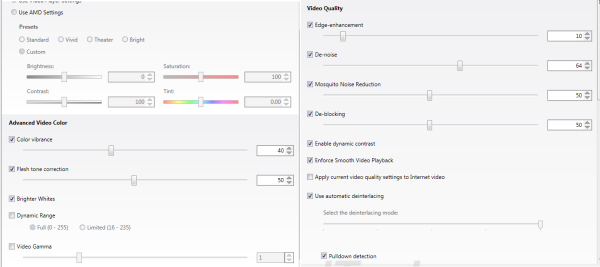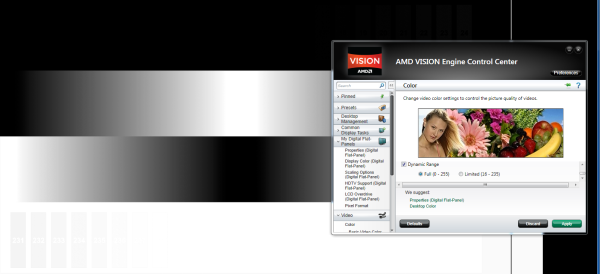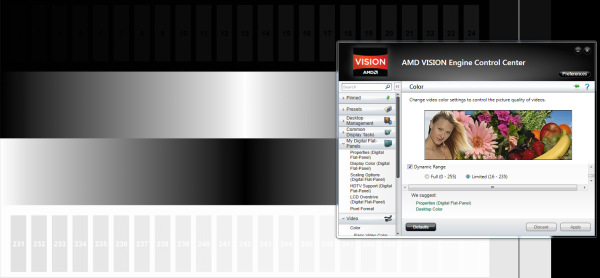AMD's Trinity : An HTPC Perspective
by Ganesh T S on September 27, 2012 11:00 AM ESTHTPC enthusiasts are often concerned about the quality of pictures output by the system. While this is a very subjective metric, we have been taking as much of an objective approach as possible. We have been using the HQV 2.0 benchmark in our HTPC reviews to identify the GPUs' video post processing capabilities. The HQV benchmarking procedure has been heavily promoted by AMD, but Intel also seems to be putting its weight behind that now.
The control panel for the Trinity GPU retains the host of options from earlier Catalyst releases. We used Catalyst 12.8 in our testing.
HQV scores need to be taken with a grain of salt. In particular, one must check the tests where the GPU lost out points. In case those tests don't reflect the reader's usage scenario, the handicap can probably be ignored. So, it is essential that the scores for each test be compared, rather than just the total value.
The HQV 2.0 test suite consists of 39 different streams divided into 4 different classes. For the Trinity HTPC, we used Cyberlink PowerDVD 12 with TrueTheater disabled and hardware acceleration enabled for playing back the HQV streams. The playback device was assigned scores for each, depending on how well it played the stream. Each test was repeated multiple times to ensure that the correct score was assigned. The scoring details are available in the testing guide from HQV.
Blu-rays are usually mastered very carefully. Any video post processing (other than deinterlacing) which needs to be done is handled before burning it in. In this context, we don't think it is a great idea to run the HQV benchmark videos off the disc. Instead, we play the streams after copying them over to the hard disk. How does the score compare to what was obtained by the Llano and Ivy Bridge at launch?
In the table below, we indicate the maximum score possible for each test, and how much each GPU was able to get. The HD4000 is from the Core i7-3770K with the Intel 8.15.10.2696 drivers. The AMD 6550D was tested with Catalyst 11.6 (driver version 8.862 RC1).
| HQV 2.0 Benchmark | ||||||
| Test Class | Chapter | Tests | Max. Score | AMD 6550D (Local file) | Intel HD4000 | AMD 7660D |
| Video Conversion | Video Resolution | Dial | 5 | 4 | 5 | 5 |
| Dial with Static Pattern | 5 | 5 | 5 | 5 | ||
| Gray Bars | 5 | 5 | 5 | 5 | ||
| Violin | 5 | 5 | 5 | 5 | ||
| Film Resolution | Stadium 2:2 | 5 | 5 | 5 | 5 | |
| Stadium 3:2 | 5 | 5 | 5 | 5 | ||
| Overlay On Film | Horizontal Text Scroll | 5 | 5 | 3 | 5 | |
| Vertical Text Scroll | 5 | 5 | 5 | 5 | ||
| Cadence Response Time | Transition to 3:2 Lock | 5 | 5 | 5 | 5 | |
| Transition to 2:2 Lock | 5 | 5 | 5 | 5 | ||
| Multi-Cadence | 2:2:2:4 24 FPS DVCam Video | 5 | 5 | 5 | 5 | |
| 2:3:3:2 24 FPS DVCam Video | 5 | 5 | 5 | 5 | ||
| 3:2:3:2:2 24 FPS Vari-Speed | 5 | 5 | 5 | 5 | ||
| 5:5 12 FPS Animation | 5 | 5 | 5 | 5 | ||
| 6:4 12 FPS Animation | 5 | 5 | 5 | 5 | ||
| 8:7 8 FPS Animation | 5 | 5 | 5 | 5 | ||
| Color Upsampling Errors | Interlace Chroma Problem (ICP) | 5 | 2 | 5 | 5 | |
| Chroma Upsampling Error (CUE) | 5 | 2 | 5 | 5 | ||
| Noise and Artifact Reduction | Random Noise | SailBoat | 5 | 5 | 5 | 5 |
| Flower | 5 | 5 | 5 | 5 | ||
| Sunrise | 5 | 5 | 5 | 5 | ||
| Harbour Night | 5 | 5 | 5 | 5 | ||
| Compression Artifacts | Scrolling Text | 5 | 3 | 5 | 5 | |
| Roller Coaster | 5 | 3 | 5 | 5 | ||
| Ferris Wheel | 5 | 3 | 5 | 5 | ||
| Bridge Traffic | 5 | 3 | 5 | 5 | ||
| Upscaled Compression Artifacts | Text Pattern | 5 | 3 | 3 | 3 | |
| Roller Coaster | 5 | 3 | 3 | 3 | ||
| Ferris Wheel | 5 | 3 | 3 | 3 | ||
| Bridge Traffic | 5 | 3 | 3 | 3 | ||
| Image Scaling and Enhancements | Scaling and Filtering | Luminance Frequency Bands | 5 | 5 | 5 | 5 |
| Chrominance Frequency Bands | 5 | 5 | 5 | 5 | ||
| Vanishing Text | 5 | 5 | 5 | 5 | ||
| Resolution Enhancement | Brook, Mountain, Flower, Hair, Wood | 15 | 15 | 15 | 15 | |
| Video Conversion | Contrast Enhancement | Theme Park | 5 | 5 | 5 | 5 |
| Driftwood | 5 | 5 | 5 | 5 | ||
| Beach at Dusk | 5 | 5 | 5 | 5 | ||
| White and Black Cats | 5 | 5 | 5 | 5 | ||
| Skin Tone Correction | Skin Tones | 10 | 7 | 7 | 7 | |
| Total Score | 210 | 184 | 197 | 199 | ||
We did some quick tests to ensure that all the post processing steps available for Blu-rays were also available for local files using MPC-HC's EVR renderer. AMD deserves kudos for being the only GPU vendor to get the local cadence detection (with respect to the shredding of overlay text) correct. In addition, they are the only ones to offer mosquito noise reduction as an option in addition the usual denoising setting. The chroma upsampling issue we noticed with the Llano is no longer an issue. With a score of 199, the 7660D with the Catalyst 12.8 drivers becomes the best performer on the HQV front. It is possible that the 7750's scores have also improved with these drivers, but we will take a look at that in another piece.
However, this doesn't mean that AMD's drivers are perfect. By default, the EVR / EVR-CP renderers rely on the drivers to supply the correct video levels to the display. As the screenshots below indicate, the meanings of full and limited seem to be interchanged.
Dynamic Range Set to Full for Video Playback (background)
Dynamic Range Set to Limited for Video Playback (background)
Setting the dynamic range to Limited (16-235) exposes black levels in the range 0-15 and 236-255, while setting it to Full (0-255) actually clips the color levels in the video in the background. This was one of the more obvious bugs that we encountered in our review process.













49 Comments
View All Comments
ganeshts - Thursday, September 27, 2012 - link
Hmmm.. all vendors tag 23.976 Hz as 23 Hz in the monitor / GPU control panel settings. So, when I set the panel to 23 Hz, I am actually expecting 23.976 Hz. However, this platform gives me 23.977 Hz which is a departure from the usually accurate AMD cards that I have seen so far.ChronoReverse - Thursday, September 27, 2012 - link
23.977 and 23.976 are so close that it's basically the same (the error in measuring tools would be as large as the difference). I'd only be concerned if it were 23.970.In any case, from looking at the screenshots in the gallery, the only frequency looking rather off is 60Hz (although my AMD card has always given similar lower than 60Hz results anyway).
ganeshts - Thursday, September 27, 2012 - link
Note that these are in Hz, not MHz. So, the margin for error is quite large. In fact, madVR statistics deliver accurate refresh rates up to 6 decimal digits (as the screenshots show).To read more on why the 0.001 Hz difference matters for SOME people, look this up: http://www.anandtech.com/show/4380/discrete-htpc-g...
In short, with the 0.001 Hz difference, the renderer might need to repeat a frame every ~17 minutes. I am NOT saying that this is a serious issue for everyone, but there are some readers who do care about this (as evidenced by the range of opinions expressed in this thread: http://www.avsforum.com/t/1333324/lets-set-this-st...
ChronoReverse - Thursday, September 27, 2012 - link
That thread on avsforum is talking about 24FPS playback where if you got 23.97x instead, it's a stutter about every 42 seconds which is terrible and clearly not acceptable (to my eye anyway).Still, I do admit that even a single stutter every 17 minutes is noticeable.
Also, I had misread that part of the review a bit since for some reason I had the impression it was saying the performance of AMD has diminished when it's still about the same +/- 0.002Hz
jeremyshaw - Thursday, September 27, 2012 - link
Wasn't AMD's first APU Brazos, not Llano? Or was it too small to really count!?ganeshts - Thursday, September 27, 2012 - link
Technically correct, but it didn't compete in the same level as the Clarkdales / Arrandales / Sandy Bridge lineup :)jamawass - Thursday, September 27, 2012 - link
"The video industry is pushing 4K and it makes more sense to a lot of people compared to the 3D push. 4K will see a much faster rate of adoption compared to 3D, but Trinity seems to have missed the boat here. AMD's Southern Islands as well as NVIDIA's Kepler GPUs support 4K output over HDMI, but Trinity doesn't have 4K video decode acceleration or 4K display output over HDMI."Although this statement is technically correct it has no real world relevance. At this time people who can afford 4k TVs ( if there any commercially available ones at this time) won't be messing around with cheap htpcs. It's an inconsequential statement made just to detract from AMD's overall superiority with this product in the htpc market.
If I was in AMD's shoes why would I dedicate resources to a nonexistent market ? Has anyone actually tested Nvidia or Intel's 4K output over HDMI to see whether they actually work? In the early days of HDCP all the video card manufacturers were claiming compliance but real world compatibility was a different matter.
'
ganeshts - Thursday, September 27, 2012 - link
I had the same caveat in the Ivy Bridge HTPC review. Surprised you didn't notice that, but you notice this :) Ivy Bridge doesn't support 4K over HDMI yet.Anyways, yes, we have test 4K output from both NV and AMD. When AMD 7750 was released, we didn't have access to a 4K display, but things changed when the GT 640 was released:
http://www.anandtech.com/show/5969/zotac-geforce-g...
I don't have a sample image ready for the 7750, but I can assure you that it works as well as NVIDIA's and I have personally tested it. In fact, AMD was the first to 4K output over HDMI.
JNo - Saturday, September 29, 2012 - link
More importantly do you have any 4K films to watch? No. Will you in the immediate future? No. Even then, when will *most* new films coming out be available in 4K? Probably in 5 years time when you'd build a new HTPC anyway.The 4K thing is absolutely irrelevant at this point (unlike 3D I'd argue because you can go into plenty of shops and buy actual 3D media).
After Hi Def came out hardware (TVs) were available quickly but it took a *long* time before there was plenty of 1080p material anyway (note use of the word, 'plenty'). Hell, most people I know are still watching stuff in SD. Laughably, 4K isn't even close to being out yet, let alone the content.
The whole thing's a red herring right now and for a long while.
Cotita - Thursday, September 27, 2012 - link
I'm not sure I'd go for an A10.Even a A4 3420 would do pretty much the same.
Heck, If I don't care about HD flash or silverlight even a E-350 is enough